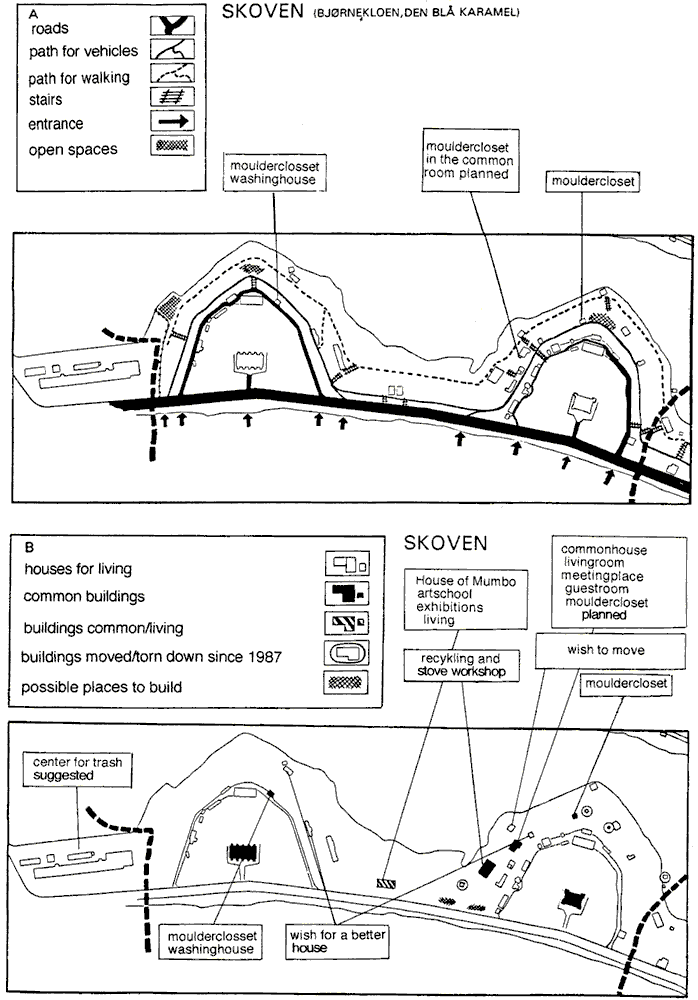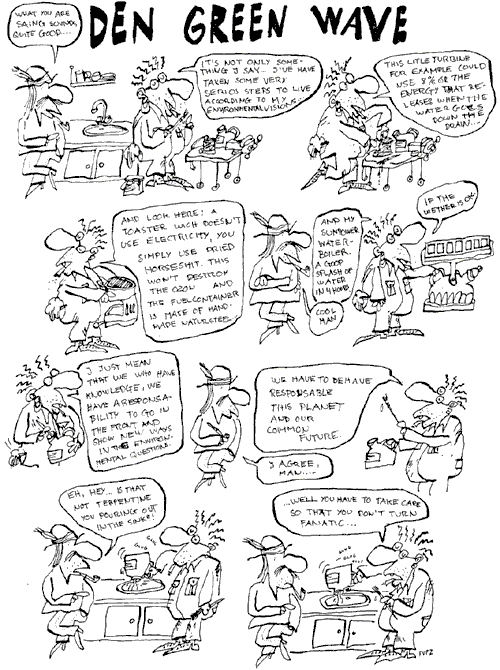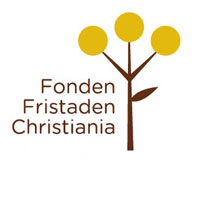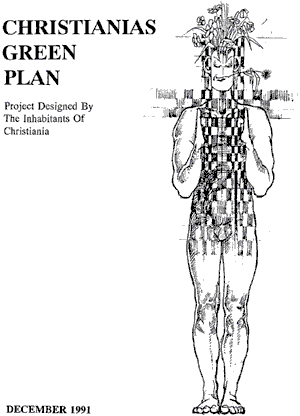 Dear Friends!
Dear Friends!
Christiania’s Green Plan is Ready!
Here is a short introduction:
First, a little history:
“Settler stop” was introduced in 1987 as one of the few rules in Christiania. First and foremost, we saw it was reasonable to preserve and show respect for the last remains of Copenhagen’s historical embankments and for the culturistic natural landscape it represented. The area was, after many opinions, already overcrowded, and pressure from folk who wanted to settle and build, together with the political pressure from the government, led to “settler stop” which has since been abolished. Moreover, since ‘87’, twenty homes have been removed or torn down.
With the law of Christiania, the National Development Directive, and the presentation of the government’s local plan, a new situation arose.
It was the normal understanding in Christiania that the distance between the theory and reality was too great in the proposed plan, and we decided to present our own plan, as a more realistic offer on how we can reach our goal, and ensure Christiania as an open, recreative area.
The draft of “Our Own Plan” was drawn up and has been the starting point for this proposal for “Christianias Green Plan”.
It has advantage over the government’s district plan, in that it can be realised without the use of force.
Loving wishes,
Christiania
Editors: Karit, Thorleif, Jørgen, Claus and Benny
Composition: Finn
Drawings: Rami, Rene J. and Fupz
Layout: Anna
Copy: Christiania
Contents
I. THE AIMS OF THE GREEN PLAN
II. OBJECTIVE GOALS AND VISIONS
a. The starting point
b. Self-administration
c. Town of the future
d. The Eco evaluation
III. THE GREEN AREAS AND BUILDINGS
– A proposal for a balanced area
IV. THE COMMUNITY SPECIFICATIONS
a. Administration of Christiania’s green areas
b. Administration of buildings and spaces
c. Working groups
V. EXAMPLES OF AREA SPECIFICATIONS
– Status quo, plans and visions
a. Map from the Factory Area with paths, stairs, vegetation, wet areas and buildings
b. Map from the Forest Area with paths, stairs, vegetation, wet areas and buildings
VI. The last page – The Green Wave
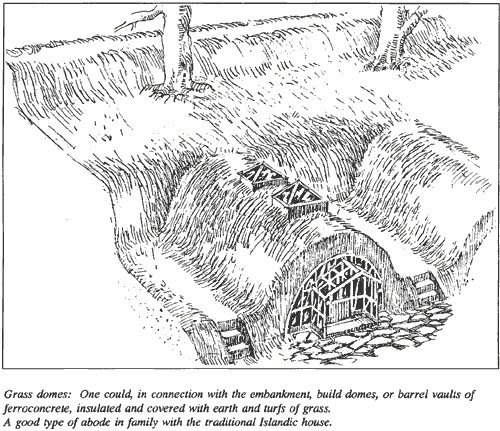
I. THE AIMS OF THE GREEN PLAN
In the Green Plan, we wish to describe and explain the visions, principles, and guidelines that we have for the physical development of Christiania.
Based on the principle of self-administration, we wish to take care of the development of Christiania as an open, creative, and constructive area, in ecological balance.
The Green Plan is a proposal for:
How we can, through the years, make Christiania even more ecologically justifiable.
How the lake and embankment areas can, with a gentle moving-round of the houses, show an acceptable aesthetic balance.
In which way Christiania can function as a green creative area, beneficial for both dwellers and friends.
The plan builds on ideas from Christiania’s childhood, the ecology group, initiatives in the different areas – arisen from many years of loving care for Christianias green areas and the lovely earth we, as a whole, live on.
Objective Goals of Christiania
To build up a self-ruled society,
where every single individual can freely develop themselves
under responsibility for the community.
That this society shall rest economically in itself,
and the common strife must still be to go out and show
that psychological and physical pollution can be prevented.
13/11 – 1971
II. OBJECTIVES GOALS AND VISIONS
a. The starting point
b. Self-administration
c. Town of the future
d. The Eco evaluation
a. The starting point
Our starting point is the historical embankments and the culture-created landscape, with nature and buildings that have stood, through a good 300 years as a military establishment, and through the last twenty-three years in Christiania’s care taking.
Ever since the buildings and the area were occupied – and opened to the public – in 1971, Christiania’s original objective has been to topic of countless discussions and visions.
One of the constant and bearing elements has been the local democracy and self-administration.
b. Self administration
The main objectives of development in freedom can be divided into 3 fundamental principles, which have been deciding for the way in which we wish to arrange ourselves:
1. The principle of self-administration and responsibility
2. The principle of solidarity
3. The principle of balance with nature
The principle of self-administration and responsibility
(For the individual, for the area, and for Christiania), together with
The principle of solidarity (that we stretch our interests from ourselves to others) may be regarded as the basic conditions for free individual development in the social community, and in balance with nature itself.
With these principles as guidelines, problems can be solved with a minimum of mutual rules. We try to reach common agreements through talk, instead of individual actions.
This kind of democracy renders most kinds of control superfluous.
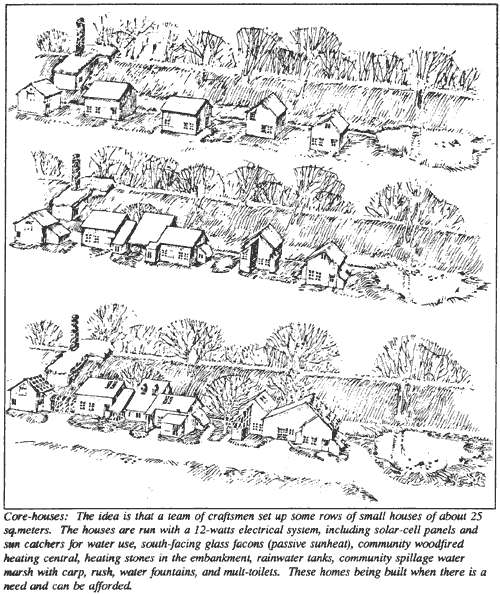
c. Town of the future
– The future’s urban society seen from an ecological point of view
People roam from countryside to the towns, miss their roots, and are left sitting in their flat, with a bird in a cage, a picture of a cow on the wall, and a potted plant on the windowsill.
It doesn’t work in the long run!
For thousands of years, human societies have lived in the worlds of plants and animals. We must make a network between our work and the wild nature.
Children like to live in and have access to the nature. Grownups like to live in and have access to both nature and culture. Nature and culture are a part of the future town.
A park is not a plant world and a Zoo is not an animal world. We want fish in the lakes! And grazing animals in the parks! And people in the nature! Without so much short-sighted, economical thinking.
Nature, culture and spirit.
– The architecture, the ecology, and the green areas of Christiania
We cannot use the “dividing-line” in the government’s local plan, which splits Christiania into a densely inhabited town and an empty park. We wish the town out in the countryside and the countryside in the town, not mashed into one porridge, but as changing areas – lovely, roomy, and full of nice surprises.
That is why we, in each area, must re-evaluate the buildings, and we should individually see our own homes as through the community’s eyes:
Is it placed indelicately in a soft, peaceful area?
Has it been build despite protests made?
Does it lay dark, cold, damp?
Would you move if there were another place?
Should my house be torn down when I move?
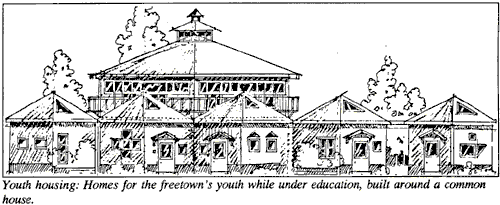
In some areas, the nature should have free scope (wild woods with rush); other areas should be cultivated by people (housing groups). We should have grass on the embankments for pets.
And Refshalevej should be made green, with combinations of paths and narrow fire roads, and with parking lots at both ends.
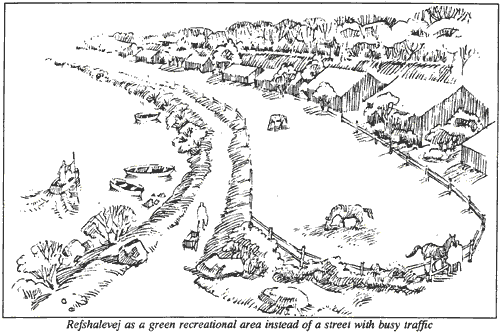
We wish a little boathouse harbour across Holmen; and canoe/kayak docking places with fire pits; and places for art exhibitions and art workshops.
We will oxidize the water with solar cells and windmill-driven fountains and water steps. We shall be better at resourcefully dispensing our rubbish. We will clean the water spillage ourselves and turn Dyssen into an island.
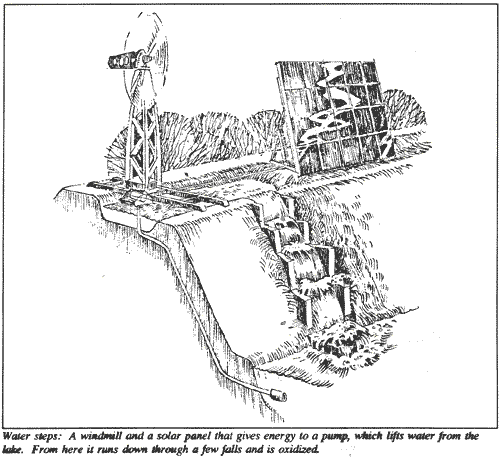
We wish for low-energy houses, solar-energy collectors and heat stores in the embankments.
– Plant and trees with water, animals, people and dogs
Our Freetown provides a rich breeding ground for a variety of plants. From goutweed to bog whortleberry. Wild plants, tame plants, shadow plants and bashful violets. Water plants and dry rushes.
First, here were: Maple, Ash, Elm, Chestnut, Thorn and Mountain Ash in tame rows. Since then, there have been planted: Poplar, Pine, Oak, Thuja, Hedges, Mirabell, Larch, Blackthorn, Pear and Apple, in wild confusion. Some grow to the heaven and other die out.
In the densely populated living areas, the Chestnut, Maple and Elm produce a lot of shadows and can be replaced by lighter trees, like Oak, Ash, Birch, when the original trees are gone. But it doesn’t work out without trees.
Wooded areas in Christiania are some places so outstanding and lavish that we have decided to preserve them as they are.
Other places need a caring hand.
We think of Christiania’s nature as: Preserved woods, parks and grass.
We carry on as usual, undaunted.
We construct natural stairs where the banks are downtrodden. We cut down the sick trees and plant new ones. We make connecting paths around the town – for our guests, with access to toilets and hand wash, fireplaces, and green areas where one can relax.
d. The Eco evaluation
– Environmental improvement initiatives in Christiania demonstrated in model form.
With this section, we will evaluate the existing environmental improvement initiatives of Christiania, to make probable the vision that many cannot see.
And so that the set-up can be compared with the existing official initiatives outside the fence, eg., Green, ecologically interested municipalities.
The model works with 3 main categories:
I. Treatment of spillage
II. Cleaner technology and products
III. Changing of consciousness and way of living
I. Treatment of spillage
a. Collection of rubbish and cleaning the drain water
The only viable possibility is local and direct handling of as much of the rubbish as possible.
In Christiania the rubbish sorting is decentralized, in that every household sorts it’s own waste and dispenses it to three centrals: The iron yard, the compost-processing plant, and the Machinehall – for glass and kitchen rubbish. We recirculate about 50% of the waste.
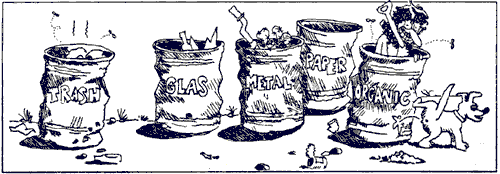
In the short sight, we will increase compost production, with local working places as side winnings, and establish new waste handling installations.
In the long sight, we want to recycle 80% of the household waste.
Christiania has nearly finished its central sewage system. In the outer areas floating waste is sorted into:
1. Excrement, to decomposing
2. The grey spillage, which is recirculated through natural root zone installations.
In short sight, we will complete the sewage system and service the mains.
In the long sight, we will locally clean and treat the wastewater.
b. Limiting drainage waste –
Water:
The existing initiatives:
Earth-toilets, households with low water use, water-saving devices in the main bathhouse, and control of water spillage.
In short sight, we will install water-meters, work with water saving, and maintenance of the water mains.
In the long sight, we will reuse rainwater.
Electricity:
Existing initiatives:
Information, low energy bulbs, low voltage installation, household windmills and sun-cells.
In short sight, we will install Electric-meters at workshops, stores, living areas, etc.
And Information, demonstrations, marketing, analysing, developing, and searching for energy-saving methods.
In the long run, we wish to develop renewable energy, and go for low-voltage systems.
II. Cleaner technology and products
a. Minor changes
Ecological products, fewer poisons, preventive health, measures, building market with recycled materials and ecological building products, building and energy advising.
b. Essential changes
Heating in christiania is decentralized and therefore our consumption is viewable – no electric heating – heating partly by second-hand wood – experiments with new oven types – 50% sun heated bathwater – experiments with waste water installations. Even though the lake has a flowing current of harbour water, it will still be necessary to give the “half dead” harbour water life, by making a row of waterfall installations on the embankments.
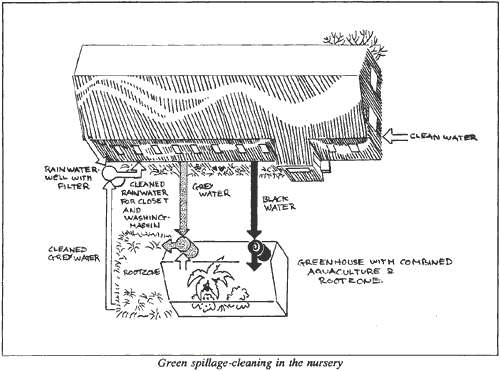
c. Changes
Car free town – only ware transportation.
Few machines – many hands.
III. Changing of consciousness and way of living
a. Change of needs
Being able to decide ourselves, together with the collective responsibility, gives a common understanding, and possibilities for change of consciousness and need. This is one of the most important single factors, because ecology points out people’s own understanding of their interaction with nature.
b. Changing of lifestyles – society structure
In a representative democracy, it is hard to change your way of life, because decisions are made centrally. And one cannot locally adjust.
In contrast to this, stands Christiania’s historical autonomy for the right of deciding over the area. Herein lies the most important single factor of the way to environmental improvement initiatives: Precisely self-deciding and direct influence via a decentralized and slow structure of decision-making.
The result of this is seen in, among other things, the making of 3-400 working places, the implementation of community projects with local economy and implementation of The Green Plan.

IV. THE COMMUNITY SPECIFICATIONS
a. Administration of Christiania’s green areas
b. Administration of buildings and spaces
c. Working groups
a. Administration of Christiania’s green areas
A little history.
The green areas of Christiania were, from the beginning, looked after in an all round way.
Sometimes, those interested would take the initiative to make playgrounds, etc. Other times, different areas have arranged a working action.
Individuals have cut down trees to let light into their houses.
Some areas have straightforward employed a “janitor” to cut the grass and cut trees, etc. Others just go and play janitor, to other’s more or less great joy.
Spring and autumn are, as a rule, community cleaning and trimming times, and in the middle of all this, there has, since 1980, been founded a gardener group, which with a small amount of funds, have done different projects in the area.
Things have gone smoothly without too many big fights, but there have been couple of conflicts, that still haven’t been sorted out.
The conflict is about “privatizing” of common areas.
The first is the dwellers of Psyaks areas incorporation of the grass lawn in front of The Grey Hall into entrenched garden allotments. The other quarrel is about 7-8 houses by the lake and on the embankment that in an irresponsible way destroys the esthetical balance in the otherwise beautiful peace filled area.
Some examples from the real life:
Some dwellers have noticed heavy wear and tear of the embankment by constant treading of tourists and runners. They talk to the gardening group, which comes and makes a natural stairway there.
One of the gardeners takes a walk by the lake and discovers five sick elm trees. The gardener group inquires into the areas where the sick trees are located, and gets permission to remove the five trees.
One area would like to have a port of the embankment thinned out and have grass instead. A couple of gardeners give advice and know-how and the people in the area do the work on an ‘action day’.
An not yet tried model:
In one area it has been agreed to renovate stairways, plant flowers, lap grass plains and make water steps, etc. The building office and gardener’s help with shaping and projecting, and support with know-how, work tools and machines, and do the work finished if the dwellers don’t get finished in the two weekends.
The future
How should the areas be looked after and treated in the future?
We can just carry on like we have the last 10 years in an interaction between biological and physical needs, the dwellers needs and the gardeners group.
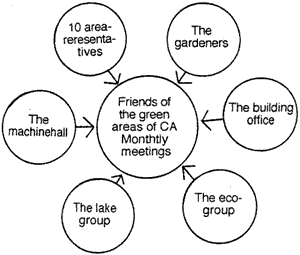
We will found a Union of Friends of Christiania’s Green Areas, including us that like them. And then we’ll just talk with the lake group, the ecology group, the Machinehall, the Gardener group, the representatives of the areas, the building office and some others.
Economy
Economy comes from Christiania’s community funds, savings from the areas and eventually from different trusts.
b. Administration of buildings and spaces
Aims
To build up a self administrated network of groups to take care of buildings and areas of Christiania.
Organisation
The builder’s meeting is an umbrella organisation for a network of self-administration groups such as the electricity group, water group, sewage group, gardener group, building and maintenance group, rubbish handling group, ecology group, building advice group, and a ‘get money group’.

The builders meeting are held once a month and include representatives from 10 areas of Christiania together with representatives from the various groups.
The future
How will the buildings be looked after in the future?
We carry on like we have done in the last many years in an interaction between the local inhabitants, the areas, and the building office.
Examples:
A local dweller wants to build a garret on the roof. He contacts the building office or one of the craftsmen and gets advice on how to proceed.
New roofing is needed. The building office is contacted and the project and economy is put to proposal. The project is carried out by craftsmen in teamwork with the dweller, or by a dweller self.
An area needs a survey on necessary up keeping a maintenance work.
The building office is contacted and the technicians and craftsmen examine the buildings. Priority listing and cost plans are put forward for proposal.
Economy
The economy comes from the community funds, the building foundation, area’s savings, and eventually trust funds.
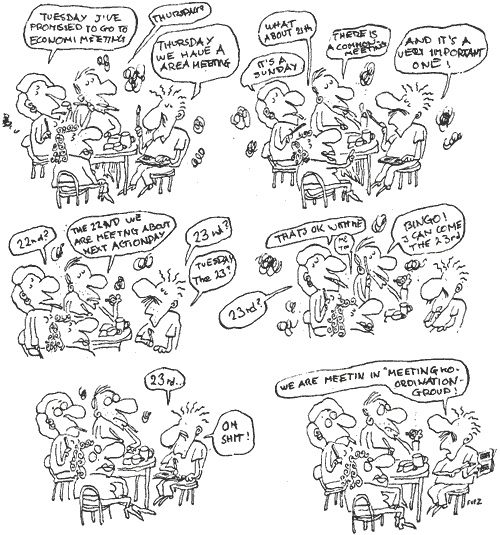
c. Working Groups
This is a list of working groups in christiania. Each group handles its tasks/responsibilities in coordination between dwellers, the different areas, and the groups/building meetings.
Waste Handling Group
* Renovation in Christiania
* Basic sorting from the roots
* Composting
Electricity Group
* Electricity-meter reading pr. joining living areas, pr. work place, pr. institution
* Electricity savings
* Maintaining, improving and renovating the existing net
Water Group
* Water saving devices, installations and accessories
* Control of spillage
– Repair of leaking installations
– Installation of Water-meters
pr. joint living areas
pr. workplace
pr. institution
* Collection of rainwater for reuse
Sewage Group
* Maintaining, improving and renovation of the sewage net.
* Establishing of new installations
Building Preservation Group
* Technical evaluation of buildings
* Maintenance, renovation, roof bettering
* Repairing of fungus damage
* Fire safety
* Advising
* New Buildings
Gardener Group
* Care taking of the green areas
* New projects
Ecology Group
* Cleaning of waste water
* Renewable energy sources
* Ecological building
Lake Group
* The lake
* Water steps
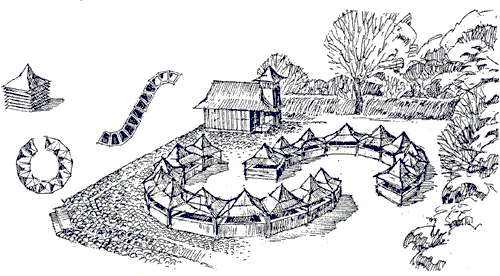
Marked Place – with small shops, that can be moved around.
V. EXAMPLES OF AREA SPECIFICATIONS
– Status quo, plans and visions
a. Map from the Factory Area with paths, stairs, vegetation, wet areas and buildings
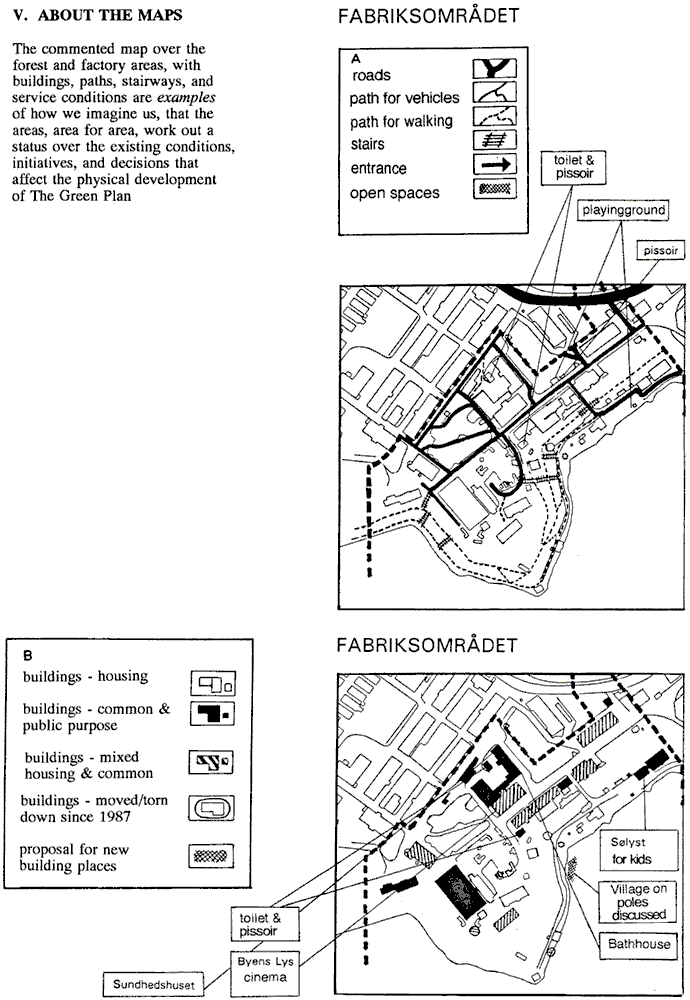
V. EXAMPLES OF AREA SPECIFICATIONS
– Status quo, plans and visions
b. Map from the Forest Area with paths, stairs, vegetation, wet areas and buildings
